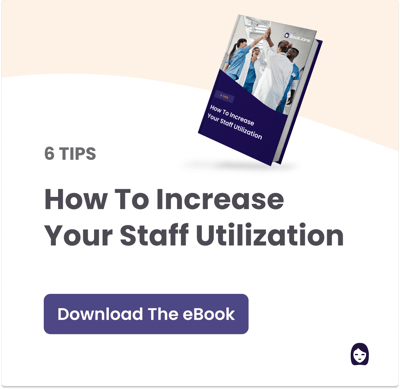
Staff Utilization and Its Impact on Your Quality of Care
Improving the way you schedule and deploy existing staff can make a big difference in your quality of care. Whether you’re bringing in existing staff to pick up shifts instead of relying on agencies, incorporating technology into your call-out process, or just giving employees more flexibility around their working lives, making good use of the staff you have doesn’t just improve the relationship you have with your employees, it also helps the patients in their care.
Nowhere is this more important than in the healthcare sector, where a global crisis in staffing is pushing facilities to the brink. Staff shortages are forcing facilities to make changes in order to move forward, and unlike other industries, consistency in healthcare staffing is crucial for the level of care. Whether it’s in the memory ward of a retirement home or the pediatrics unit at the hospital, there’s always a benefit to seeing a familiar face — and for staff busy keeping up with patients and helping coworkers run a shift, knowing what to expect can be the key to keeping things running smoothly.
What is Staff Utilization (and How Can it Be Better)?
Staff utilization is about making the best possible use of the employees you have. Plenty of healthcare facilities scrambling to fill shifts are turning to staffing agencies instead of their existing workforce, mostly thanks to an outdated process for callouts that keeps employees out of the loop. In the traditional model of healthcare staffing, when an employee calls out, the facility administrators in charge will do manual phone calls to each employee on a list. This is not only time consuming — and inconsistent, since the employees at the top of the list can end up being called in more often — it’s also not the best way to optimize your level of staff.
If you’re a nursing home, retirement community, long-term care center, daycare, or other facility that requires specially trained staff to fill shifts, you’re probably aware of the time involved in getting employees ready to come work for your facility. Even if the care services they offer are standardized (such as personal support workers or RNs), they’ll need training on your specific protocols, difficult patients, co-worker needs, or equipment before they can start work. Since training new staff takes time (and money!), making good use of the ones you have on your payroll just makes sense. But utilizing staff more efficiently isn’t just good for your bottom line — it’s also great for both patients and staff.
Better Staff Utilization Improves Patient Relationships
Healthcare work is fundamentally different from customer service — patients needing care are often vulnerable, frightened, exhausted, or in pain, and seeing familiar faces (especially friendly ones!) can not just make their day more pleasant, it can also be the difference between feeling scared and feeling safe.
A facility with well-utilized staff can not only offer its residents more consistency in terms of protocols, procedures, and quality of care, it can also make sure employees are coming to work motivated, refreshed, and ready for the job. When health care workers show up to unfamiliar facilities, understaffed shifts, or work overtime hours, they’re burned out and unhappy — and losing the level of connection they have with their patients can make things worse.
“It's heartbreaking because they're [like] your family, and you'd never want to come home and do that to your family,” says an Ontario PSW interviewed by CBC. Improving staff utilization in your facility can not only help fill shifts, it can also strengthen the bonds between staff and patients, give workers an idea of what to expect, and help make residents feel comfortable with their caretakers.
Better Staff Utilization Takes Pressure Off Workers
"You're starting with the bare minimum, and as soon as you have a sick call, you're bailing water," adds another PSW profiled by CBC. While their facility relies on clinical aides and nursing students to fill shifts, the overwhelming trend in healthcare facilities is towards coming up short. According to Health Force Ontario, half of PSWs last less than five years in the sector, and almost half of those left the job due to burnout — which is bad news for the industry unless practices start to change.
Using your staff more efficiently can help take some of this pressure off workers. When more of your workforce on duty is familiar with the expectations of the facility and is optimized around filling shifts, work ends up being less stressful overall. And when you split hours more evenly across your staff, your employees work less overtime and end up providing better quality care.
Better Staff Utilization Prevents Turnover
While full time workers might be feeling burned out, part-timers are often looking for shifts — especially at the same facility, where in addition to familiarity with the residents and protocols, they get to avoid the burden of traveling from place to place.
The same Health Force Ontario research indicates that turnover is the highest among part time employees, especially those in entry level positions. These employees are the ones who are likely to work at multiple facilities to make ends meet, and improving staff utilization through scheduling — especially when assisted by technology, which can help part time workers pick up shifts when they can want them and give them more control over their day — can keep these workers happy while also leveraging more from your existing staff.
Given that so many facilities are facing the strain of burnout, overtime, understaffed shifts, and increasing patient needs, small changes can have a big impact on your workplace’s level of turnover. When you’re competing against other facilities for the same pool of health care workers, better utilization rates, shorter hours, or more flexibility over shifts can all help make your organization an employer of choice.
How BookJane Can Help
No matter what kind of staffing challenges you’re facing during the pandemic, having the right tools on hand can help. Using a technology solution like J360 Workforce can provide the transparency, flexibility, and foresight you need to keep things running smoothly.
J360 Workforce is an all-in-one shift fulfillment platform, built for the healthcare industry. BookJane helps senior living facilities and hospitals across North America quickly and effortlessly find shift coverage with automated call-out and scheduling, alleviating stress and inefficiencies at scale, so they can focus on delivering the very best patient care possible.





